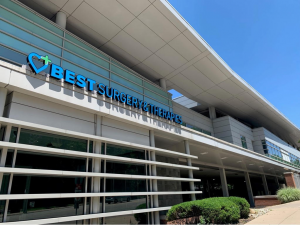Lateral Epicondylitis - Tennis Elbow
Lateral epicondylitis, also known as tennis elbow, is a repetitive motion injury that causes elbow pain and limited range of motion. As the name implies, it is common among tennis players but it can also develop as a result in any activity that involves frequent elbow movements. Since our elbow joint undergoes significant strain on a daily basis, tennis elbow is a frequently occurring injury among both athletes and people who work in jobs that involve manual labor.
Tennis elbow is a highly manageable injury and it is possible to find treatment that can improve long-term elbow and arm function while relieving pain. At BEST Health System, we believe in helping people learn about the causes of pain and the therapeutic options available. To learn more or to get answers to any questions about the following guide, please get in touch with our dedicated team at any time.
Causes
In either arm, the elbow joint connects the upper arm to the lower arms enabling the basic bending motion needed to perform a wide range of everyday activities. The elbow joint basically consists of three bones – the upper arm and two bones in the forearm. The muscles and tendons in the forearm are connected to bony knobs on the upper arm called epicondyles. Every time the arm is bent, these tendons stretch against the bones in the elbow joint.
With overuse due to strenuous activities or repetitive motions, the tendons in the forearm muscles can develop small tears and become inflamed. A common contributor to tennis elbow is believed to be stabilizing muscle in the wrist becoming easily fatigued and increasing the strain on the forearm tendons.
Along with swinging a tennis racket, motions that involve arm rotation or bending, such as painting, using plumbing tools, or hammering nails, can all increase the risk of lateral epicondylitis. This is why this condition is so common among the following professions:
- Carpenters and construction workers
- Plumbers
- Painters
- Factory workers
- Chefs and butchers
- Professional athletes
Tennis elbow is most common among people aged 30 to 50, although since it is an activity-related injury it is possible for people of any age who perform repetitive elbow motions to be at risk.
Conservative Treatment
For a tennis elbow diagnosis, the initial treatment recommendation will usually consist of conservative, or nonsurgical, therapies. Since tennis elbow is an injury that can improve, the goal of treatment is to both manage symptoms and take steps to promote the healing process.
Specific treatment plans vary depending on the severity of the injury and the patient’s lifestyle and profession, but will often consist of:
- Resting the elbow and modifying activities to prevent overuse and strain
- Taking over the counter medications such as nonsteroidal anti-inflammatory drugs (NSAIDs) to reduce pain and inflammation
- Physical therapy to mobilize soft tissue, learn proper elbow mechanics, and address muscle imbalances
- Corticosteroid injections to help lower inflammation for an intermediate period of time
It takes some patience to find an effective treatment strategy, but it’s important not to rush back into activities that can exacerbate the injury.
Symptoms
As a progressive repetitive motion injury, tennis elbow symptoms can come about gradually. The pain and inflammation caused by a fully developed tennis elbow results in symptoms that can be very painful and limit the range of motion. The most commonly reported symptoms include:
- Burning pain on the outside of the elbow
- Pain and soreness in the forearm
- Weakness in the hand that affects the ability to grip and turn objects
- Some tennis elbow sufferers report night pain
For any minor elbow or arm pain, resting, using an ice pack, and taking over-the-counter medication if needed is the initial treatment recommendation. If the pain persists for longer than a few days or suddenly worsens, patients should see a qualified physician for a diagnosis.
Diagnosing Tennis Elbow
Similar to other conditions and injuries, the first step in diagnosing tennis elbow is for the doctor to perform an evaluation. In most cases, the doctor will review medical history, ask questions about your specific symptoms, and perform a physical examination to test your range-of-motion and painful spots.
Next, physicians will often order tests to confirm the presence of lateral epicondylitis. Diagnostic imagery such as an X-ray or an MRI can show telltale signs of tennis elbow or can rule out other conditions such as arthritis.
If a doctor diagnoses tennis elbow to be the source of symptoms, the next step is to work together to create a treatment plan to manage symptoms and help promote recovery.
Surgery
For an injury such as tennis elbow, surgery is a last resort option for cases where weeks and months of conservative treatment have been attempted but symptoms still remain. The goal of tennis elbow procedures is to remove any heavily damaged soft tissue and muscle and then carefully reattach the tendon to the elbow. This can be accomplished using minimally invasive techniques on an outpatient basis thanks to advances in surgical technology.
After the procedure, patients will be given detailed instructions on recovery and will generally undergo some form of physical therapy and rehabilitation to help regain function and strength in the affected arm.
Reach out to BEST Health System
At Best Health System, our highly skilled and compassionate staff has extensive experience in helping people diagnosed with tennis elbow get back to a healthy and active lifestyle. We have a full array of non-surgical options at our state-of-the-art facilities. To learn more about becoming a candidate, contact us today.
If you have experienced any of these symptoms or recieved a diagnosis and need treatment, BEST can help. Take the first step towards relief today.
Related Articles
A Map of BEST Health System's Ohio Locations
BEST – The Health System Redefining Care Throughout Ohio BEST Health System is a modern healthcare system with accessible locations throughout the state of Ohio. […]
A Checklist for Car Accident Survivors
The Risk of Driving In the case of a car accident, it only takes a few seconds for everything to change. It has been estimated […]
Osteoarthritis and Spinal Stenosis
What is Osteoarthritis? Osteoarthritis is one of the most common causes of spinal stenosis, according to the American College of Rheumatology. Further research shows that […]
Five Treatment Options to Help with any Type of Tendonitis
Tendonitis, also spelled tendinitis, is an injury caused by inflammation and damage to tendons. In the body, tendons are tough flexible pieces of cartilage that […]
Six Steps to Diagnose a Ganglion Cyst | BEST
A ganglion cyst is a type of noncancerous lump that develops on the back of the hand. This is the most common form of lump […]



